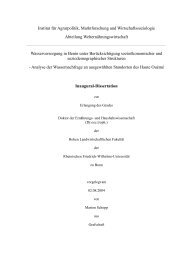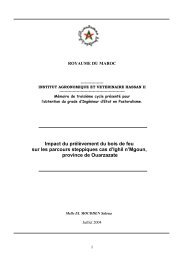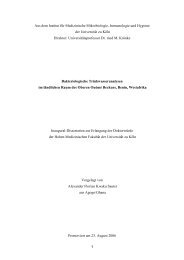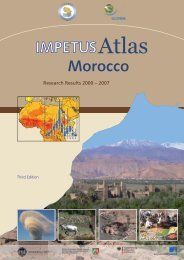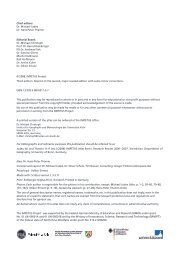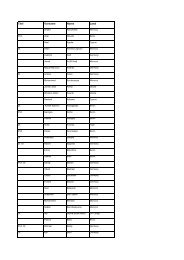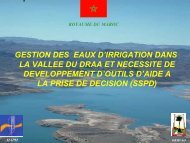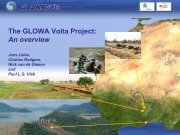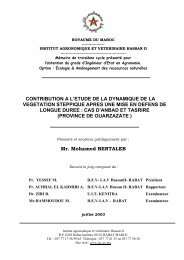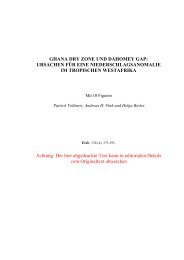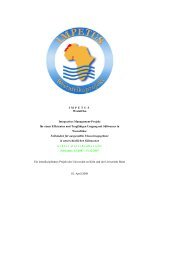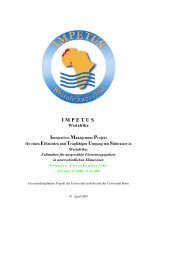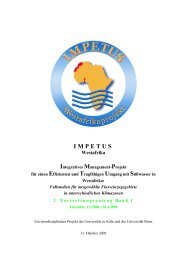Impetus - Universität zu Köln
Impetus - Universität zu Köln
Impetus - Universität zu Köln
Create successful ePaper yourself
Turn your PDF publications into a flip-book with our unique Google optimized e-Paper software.
40IMPETUS Development of scenariosFor all conceivable scenarios an increased warming of the atmosphere through rising greenhousegas concentrations is to be expected. The temperature increase will lead to a 200 m rise of thesnow line in the High Atlas and thus to an enhancement of the rainfall component of the precipitationwhich can percolate directly and thus enter the hydrological budget in the Drâa valley.Higher air temperatures reduce the sublimation of snow and enlarge the snowmelt. This holdstrue for all three scenarios, X, Y, Z.Storyline for scenario X: Enhancement of the humidity advectionIn the frame work of IMPETUS all processes leading to precipitation in the area south of theAtlas Mountains have been thoroughly investigated. Precitation in the High Atlas is generatedmainly by low pressure activity of the mid-latitudes during the cold months. Precipitation systemsreaching the ridges of the High Atlas from the north can also bring precipitation to thesouthern slopes. These systems are responsible for most part of the available water in the Drâaregion since especially in winter major parts of precipitation are blown in the form of snow fromthe north over the ridges of the Atlas Mountains. In the basin of Ouarzazate and in the southernoases this mechanism has no influence on the precipitation. In the latter regions precipitation isgenerated mainly by troughs or cut-off lows located west of the Moroccan coast. These systemsdraw their humidity either from local evaporation over the ocean or by tropical-extratropical interactionfrom areas south of the Sahara. In the latter mechanism a moisture input from convectiveclusters or squall lines over tropical Africa and the adjacent Atlantic Ocean, which is transportednorthward on the eastern side of a subtropical upper-level trough located to the west ofnorthwestern Africa, is a decisive factor. The advection of moist air from the south toward theslopes of the Atlas Mountains leads to forced lifting which results in the condensation of watervapour and eventually in the formation of precipitation.Due to the atmospheric warming as a result of increased greenhouse gas concentrations the aircan take up and transport more humidity. In this scenario X we assume that the dynamic processesof precipitation generation in the Drâa valley remain unchanged. The enhanced humidityadvection owing to the temperature rise leads to increased precipitation amounts. The statisticodynamicalregionalization of global climate model simulations with the help of the IMPETUSatmospheric model chain shows that for the southern oases a slight increase of cut-off lows westof the Moroccan coast can be expected. Although these events are quite rare they are responsiblefor the major part of the precipitation in the basin of Ouarzazate and in the southern oases. Onlya slight increase of such events leads to a noticeable rise of precipitation amounts. For the southernoases the area averaged annual precipitation amount rises from 31.9 mm to 34.3 mm(ECHMA4 climate scenario) or even to 40.5 mm (ECHAM4 climate scenario). In addition therise in air temperature is responsible for the increase in precipitible water available per event.Storyline for scenario Y: Displacement of the NAOA high number of climate models predict a displacement of the poles of the North Atlantic Oscillation(NAO; defined as normalized pressure difference between Iceland and the Azores) towardthe northeast leading to enhanced storm activity over northern Europe and drier conditions in the



